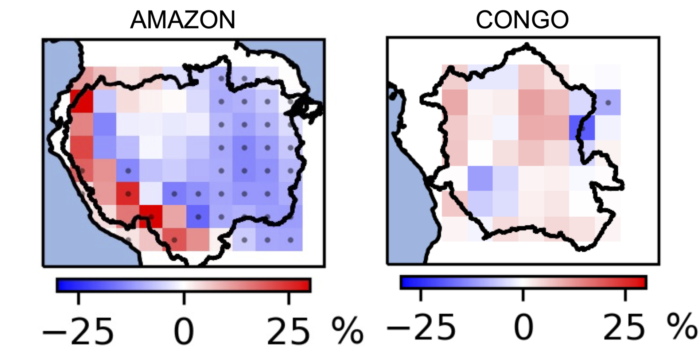Tropical forests recycle rain – can all climate models predict this?
Researchers at the University of Leeds have found that a vital rainforest process, known as rainfall recycling, is predicted less reliably by scientific models in the Amazon than the Congo. The study was published recently in Geophysical Research Letters and is freely available online.
Rainfall recycling is an important process in tropical regions and may be responsible for as much as three quarters of all rainfall in some areas. Rain that falls on tropical forests is recycled back to the atmosphere through evaporation, providing essential moisture for more rainfall events downwind, adding to incoming moisture from elsewhere. This process of rainfall recycling, which is vital for sustaining the rainforest, is disrupted when forest is cut down.
Farmers are dependent on reliable rainfall for their crops and livestock and demands for water resources in urban areas are also growing. For researchers to understand how deforestation in the Amazon and Congo might impact regional rainfall it is vital that climate models accurately represent the fraction of rain coming from recycled moisture.
Dr Jess Baker and Prof Dominick Spracklen found that scientific models of rainfall recycling were relatively accurate in the Congo, but tended to underestimate recycling in the Amazon in some seasons. The Amazon’s dry-to-wet transition season was particularly affected.

Maps of the Amazon and Congo river basins showing the percentage by which current models over-predict (red shading) or under-predict (blue shading) rainfall recycling in approx. 300km2 regions during the September-November period.
Models of rainfall recycling are under-estimating quantities by up to 25% over large parts of the Amazon (see areas of blue shading in the image above). The difference between model and real-world values is suggested to be the result of underestimating local evaporation and overestimating wind-speeds and the amount of water vapour coming into the Amazon basin from the Atlantic Ocean.
Dr Jess Baker, the lead researcher on the study, explained:
Tropical regions are experiencing high rates of forest loss, with widespread impacts on the climate system. Models need to represent relationships between forest and rainfall so we can accurately predict how rainfall might be affected by future deforestation and highlight the local and regional benefits of forest conservation.
The study is available online via Geophysical Research Letters.

